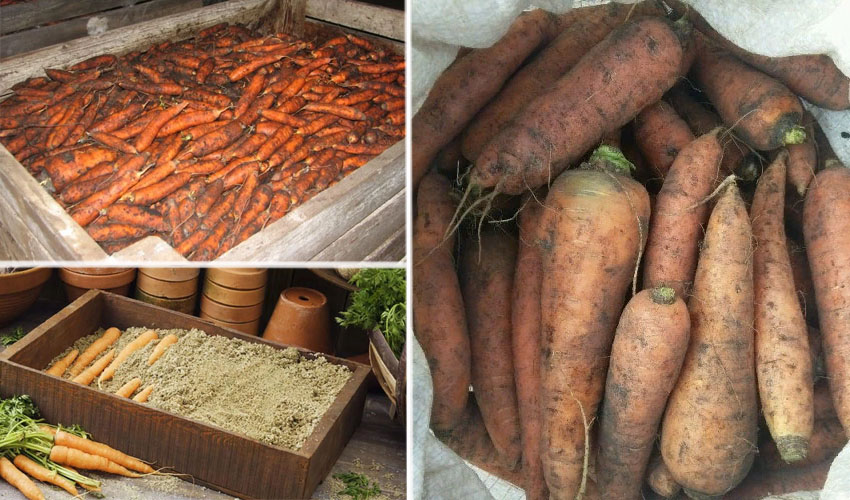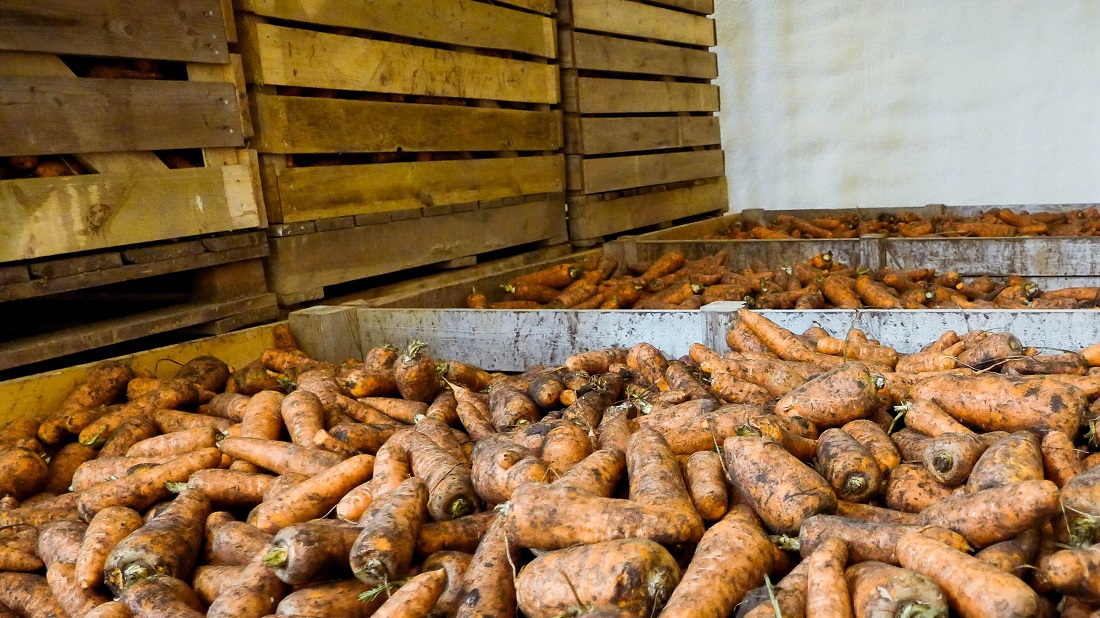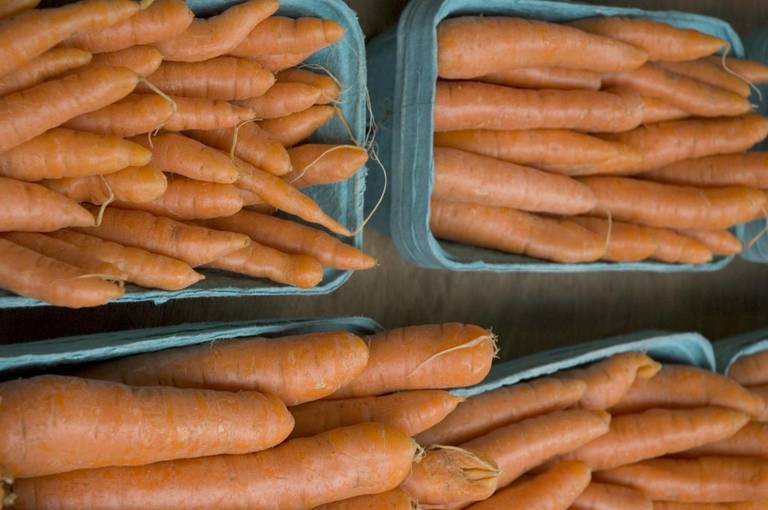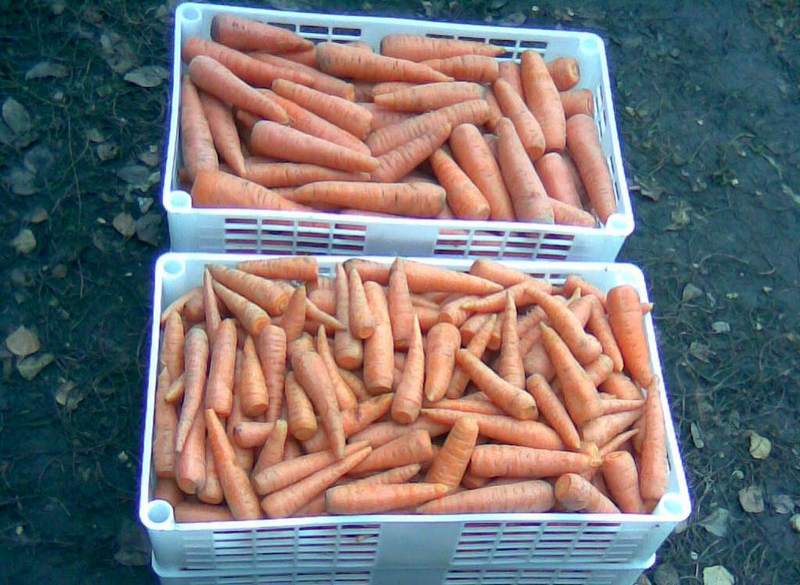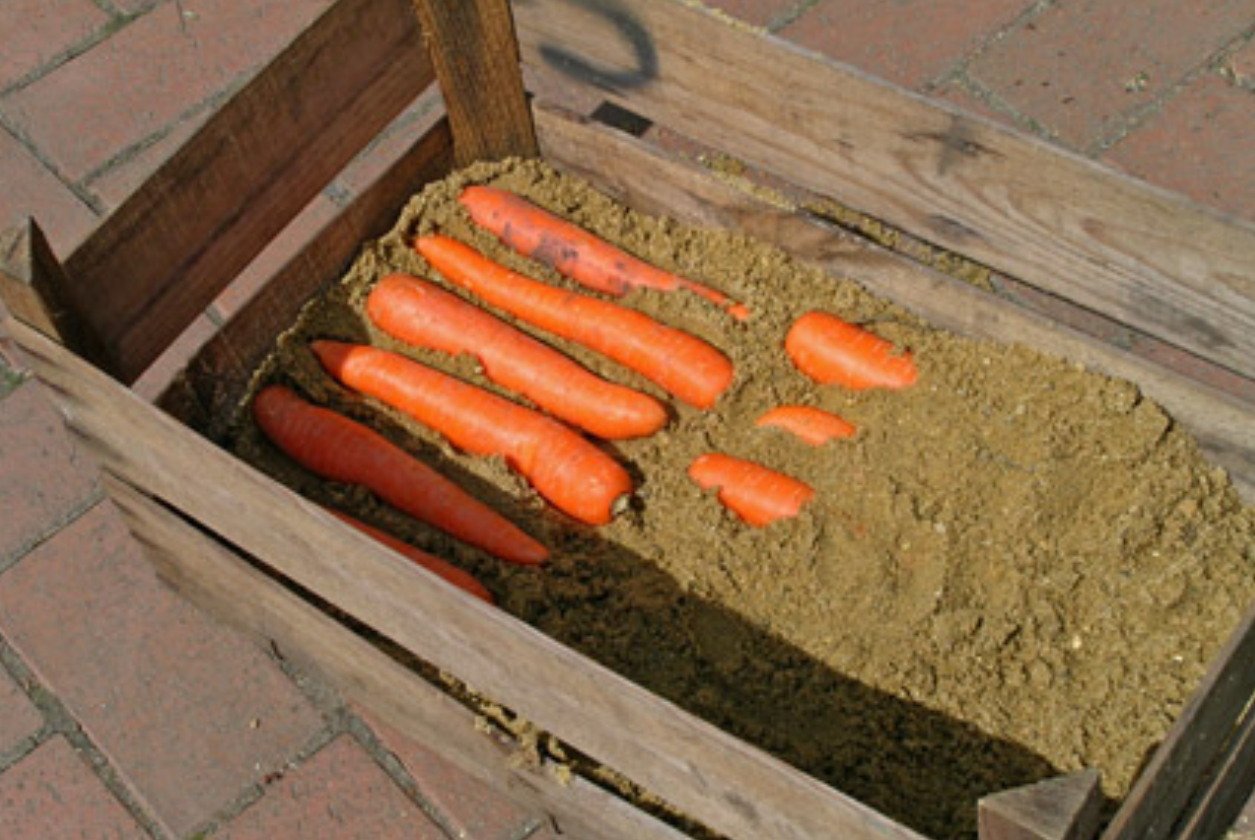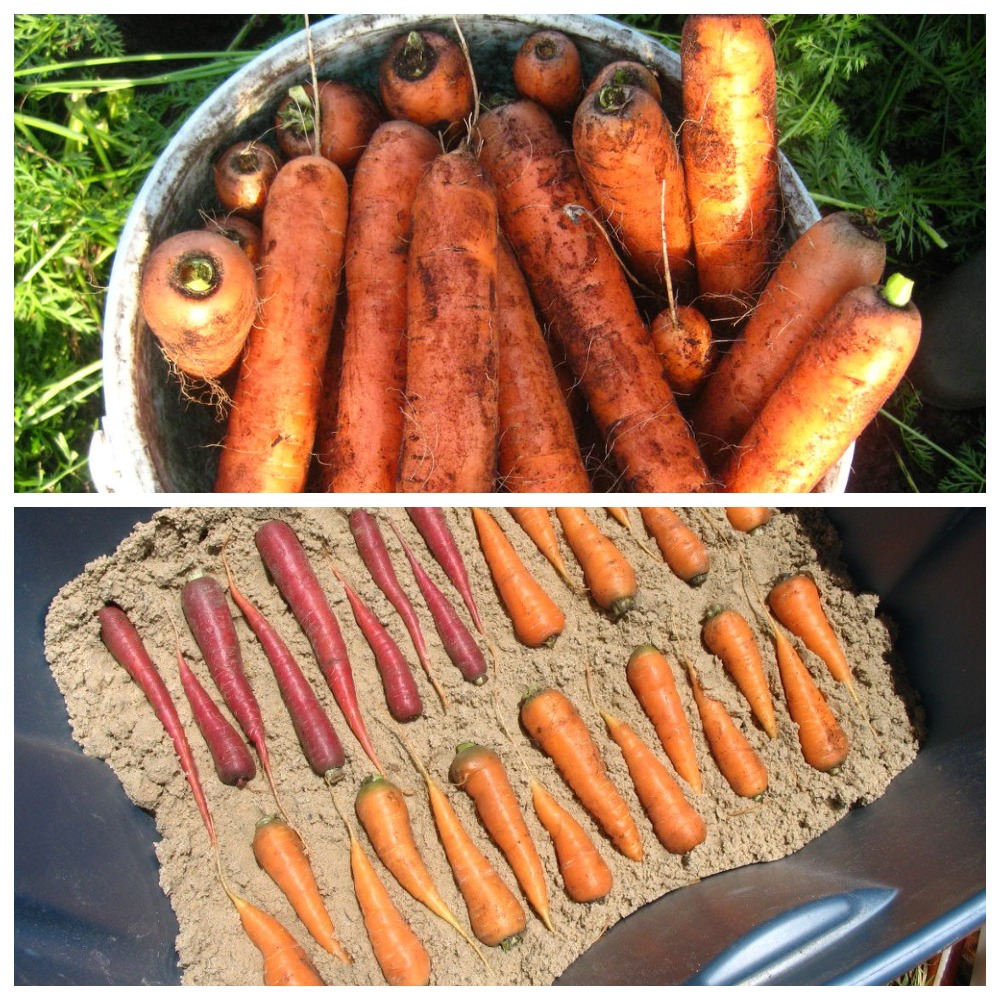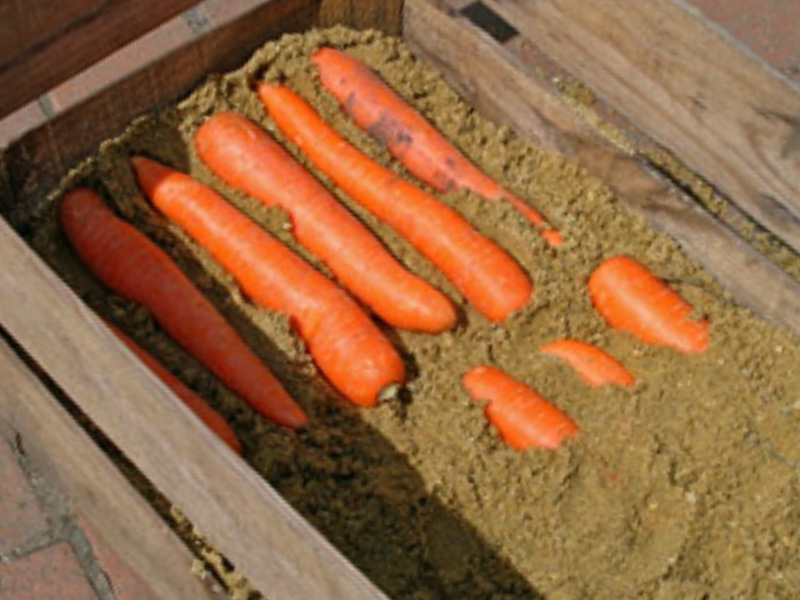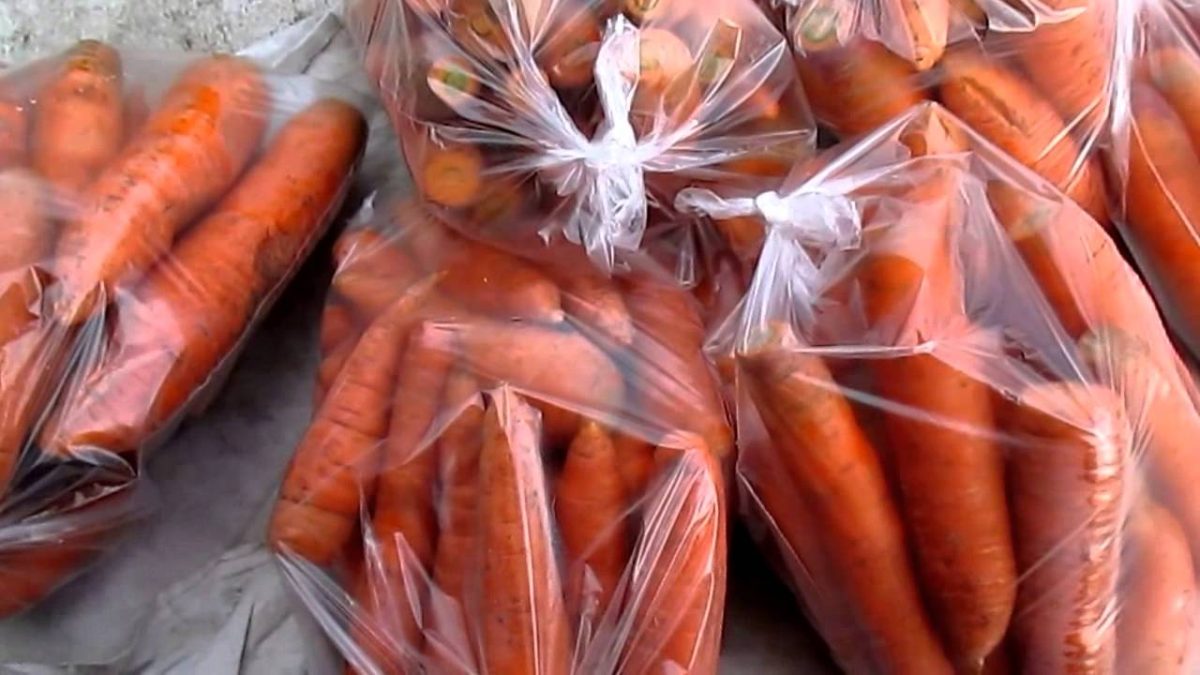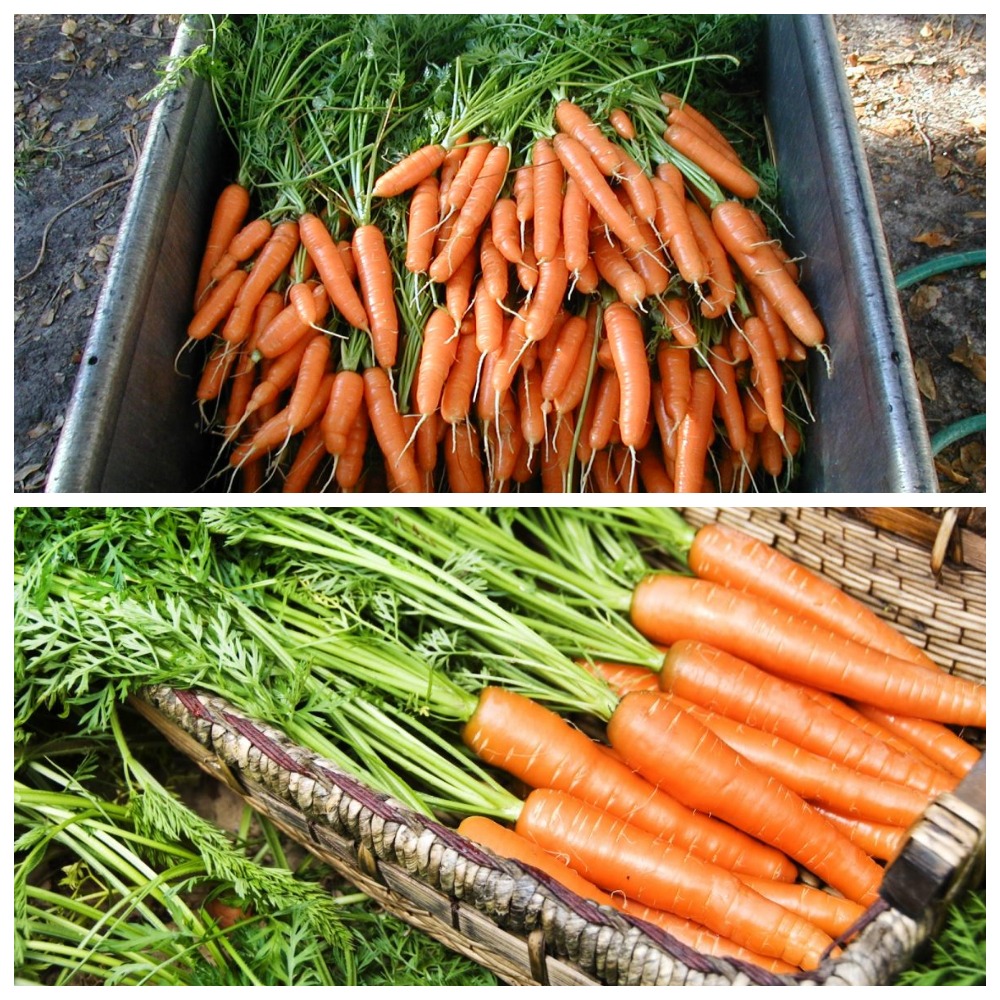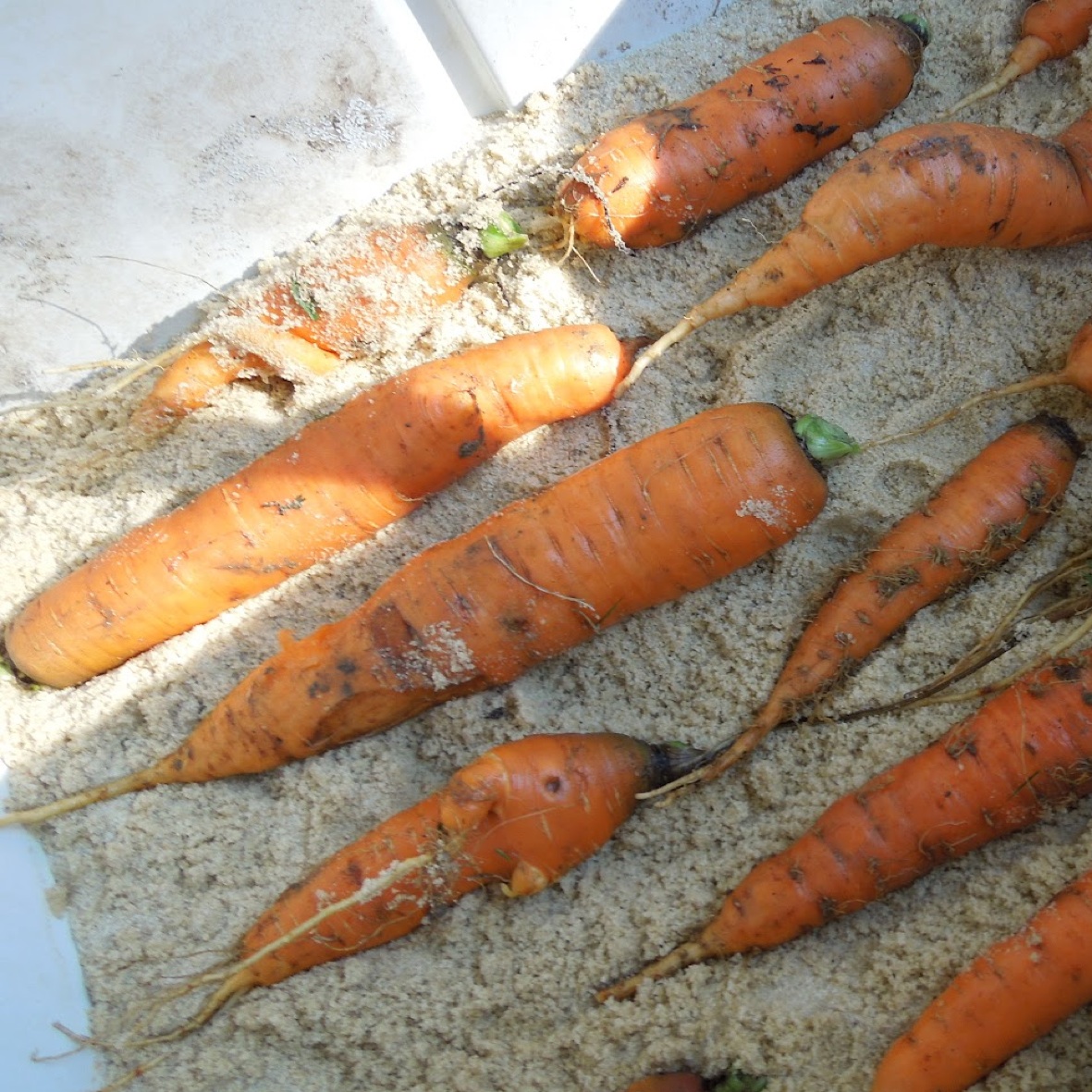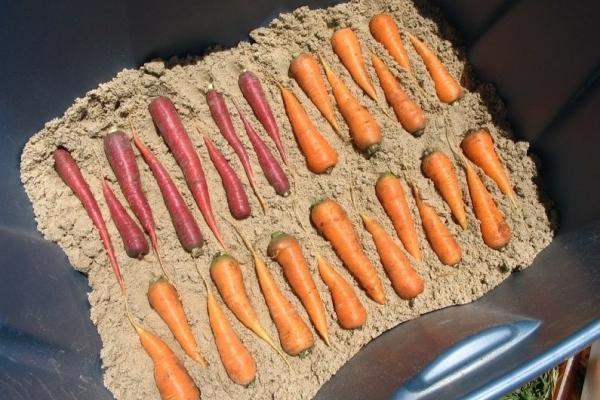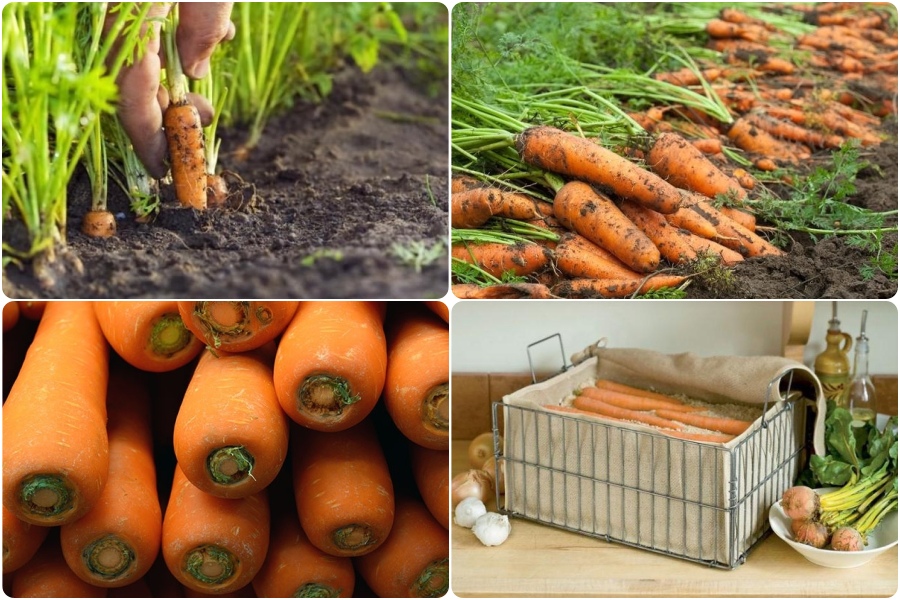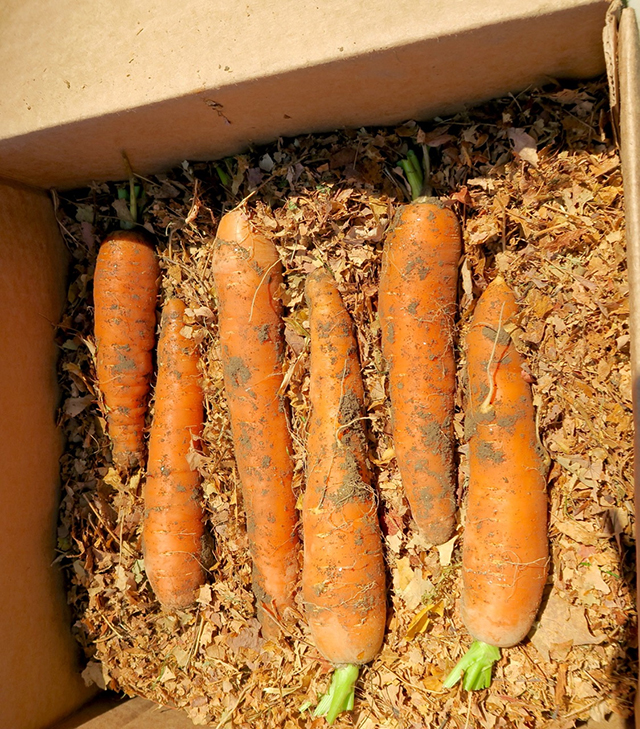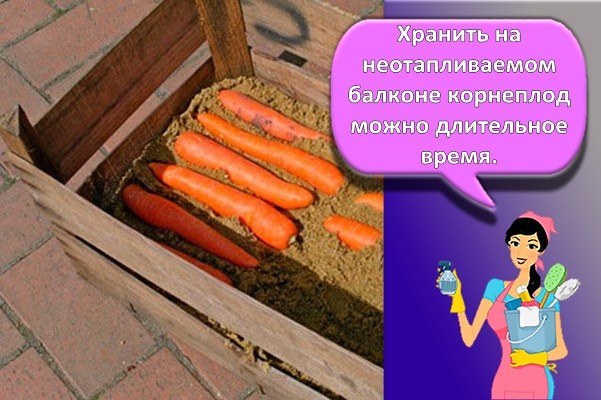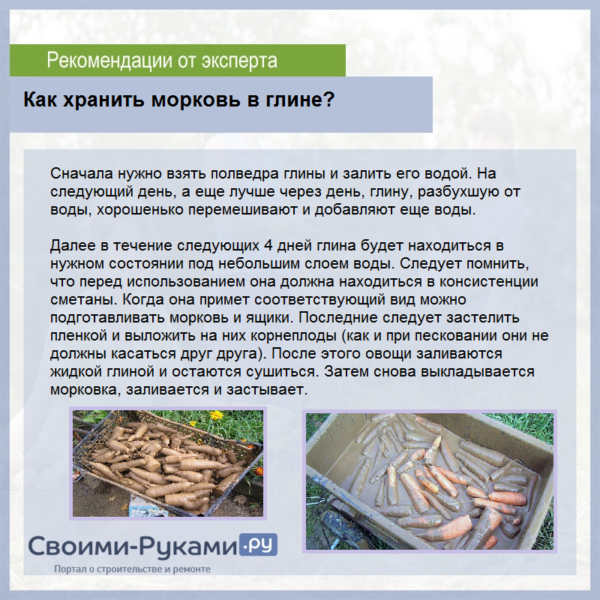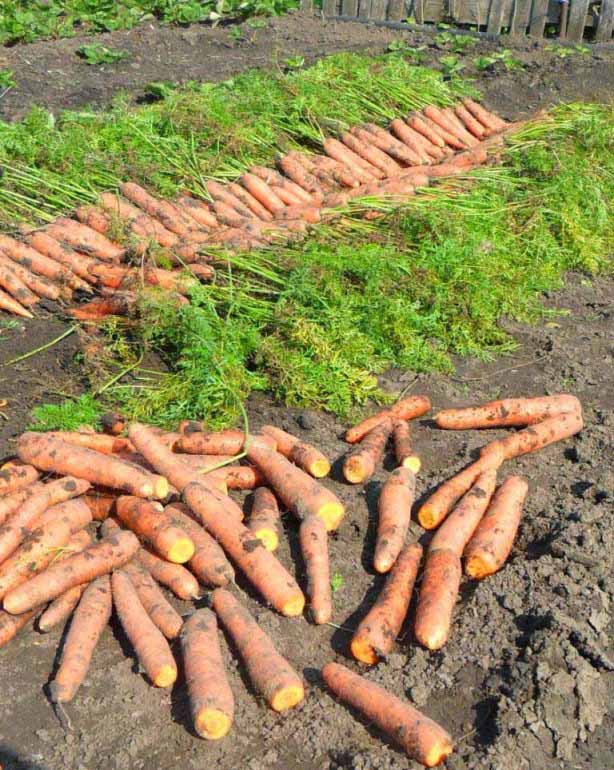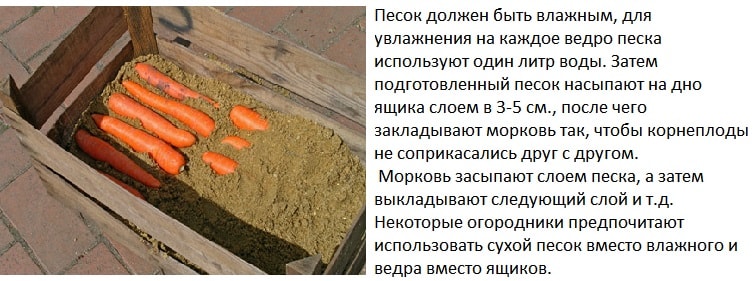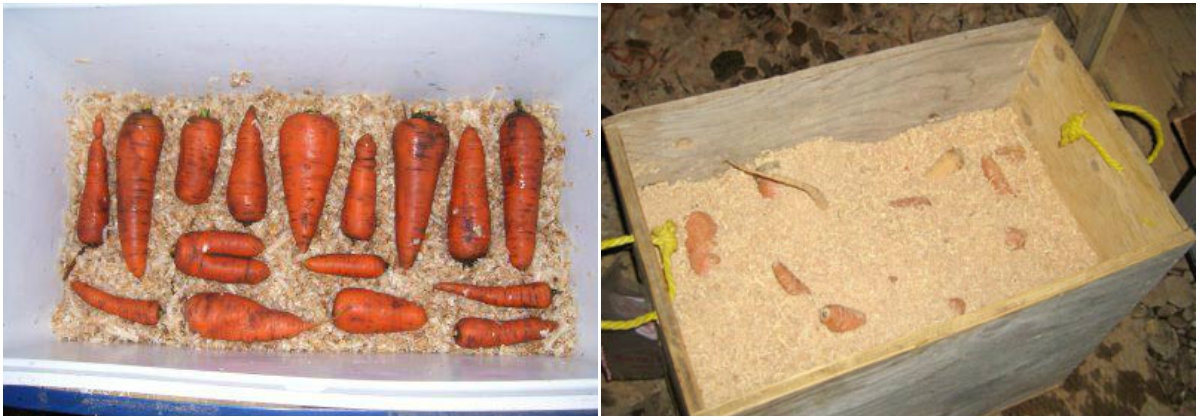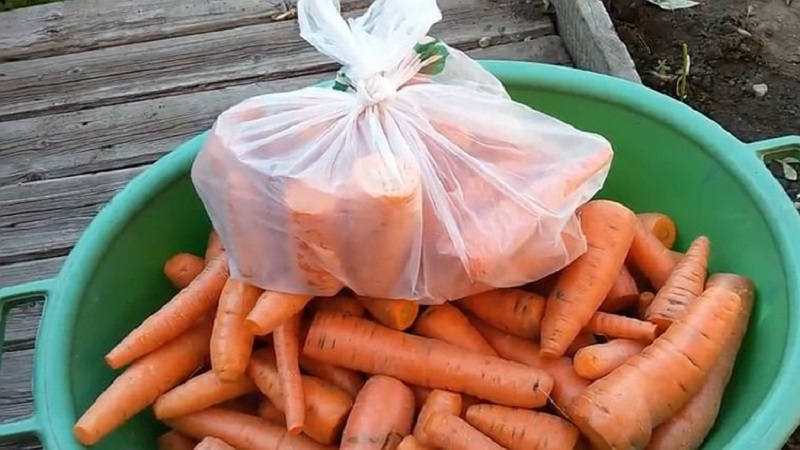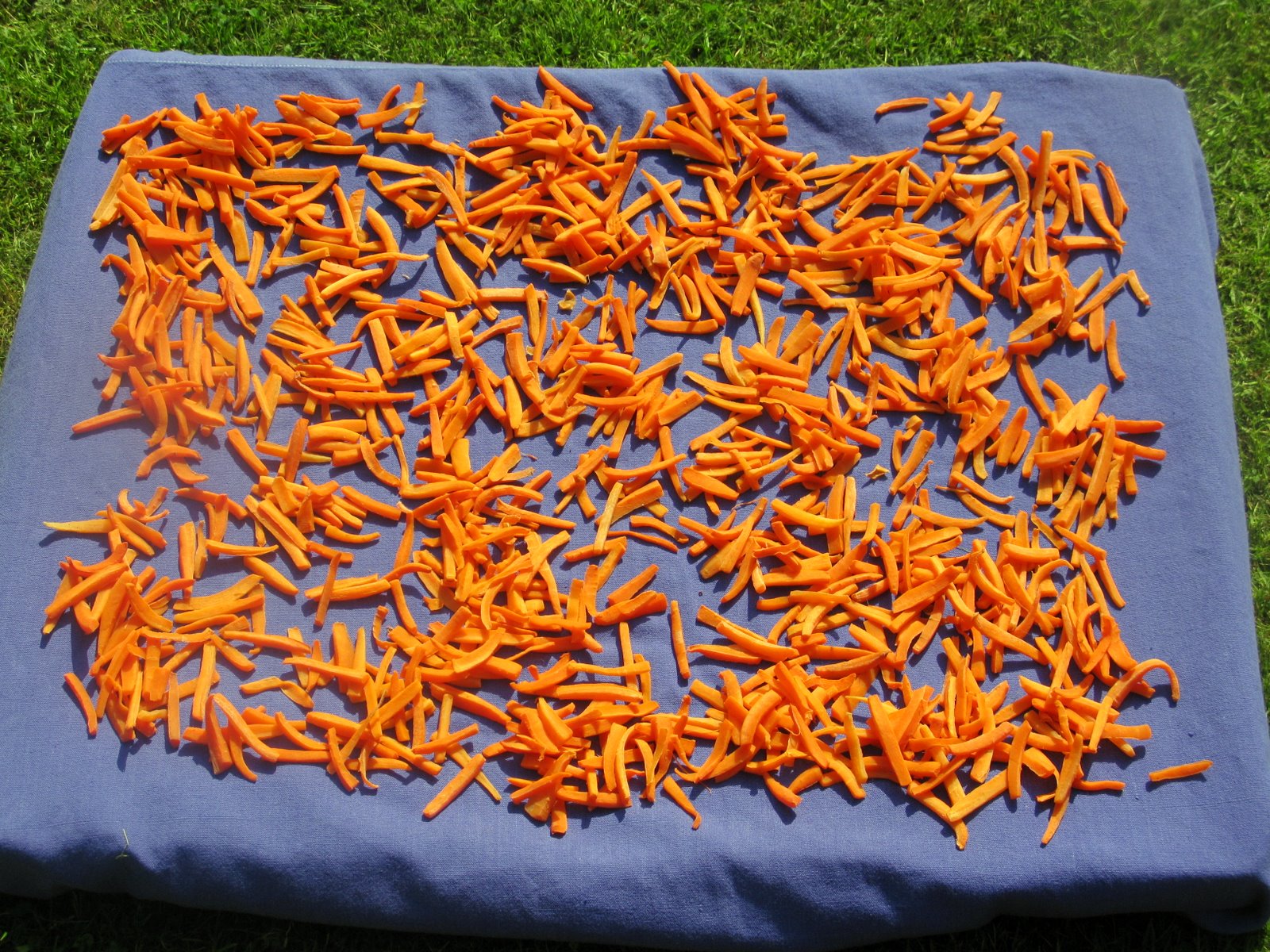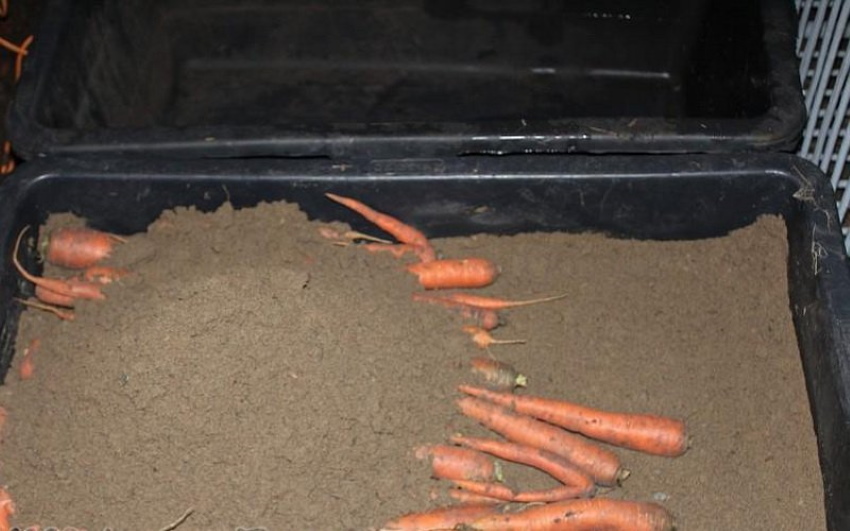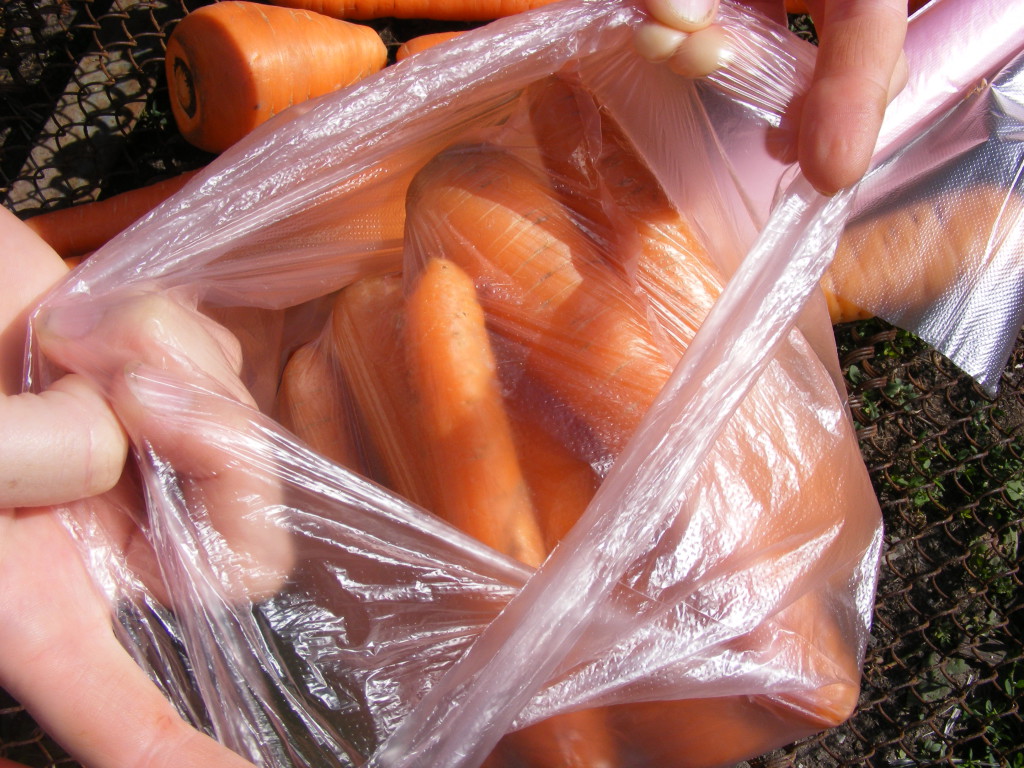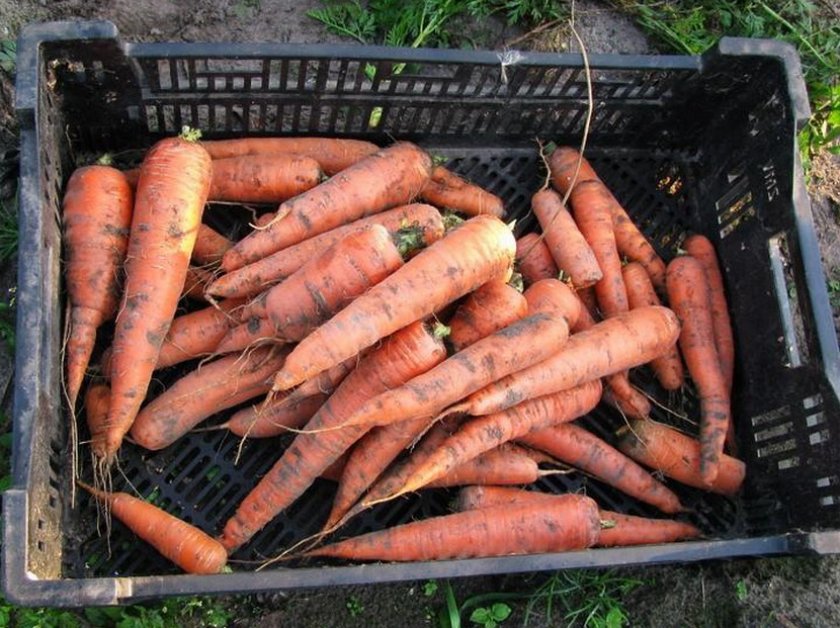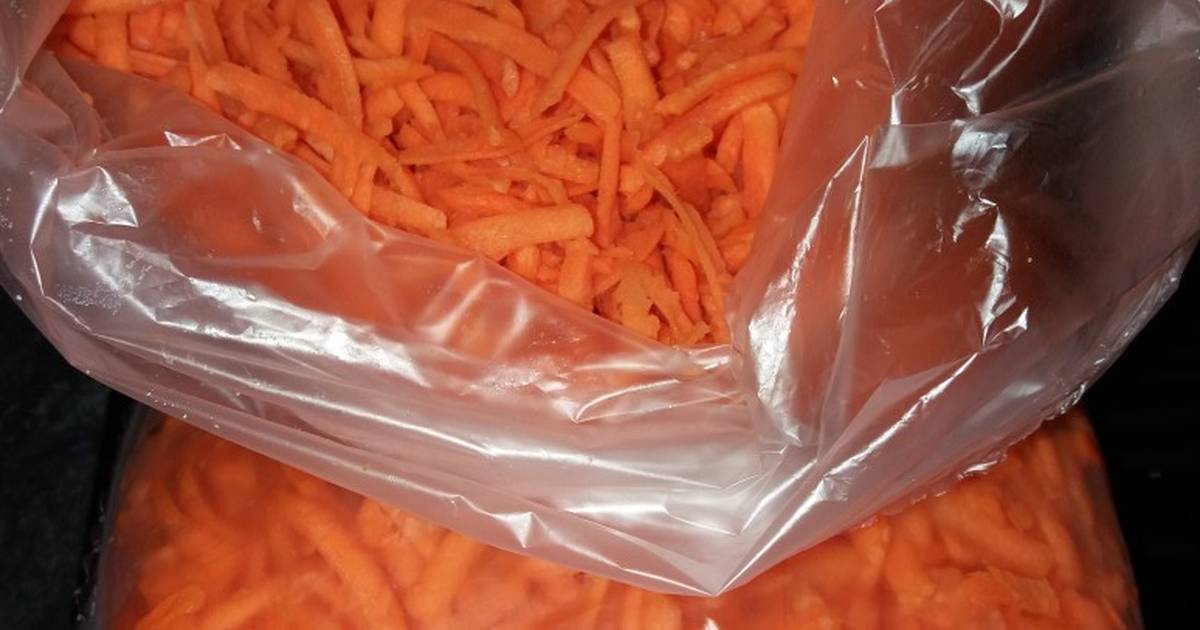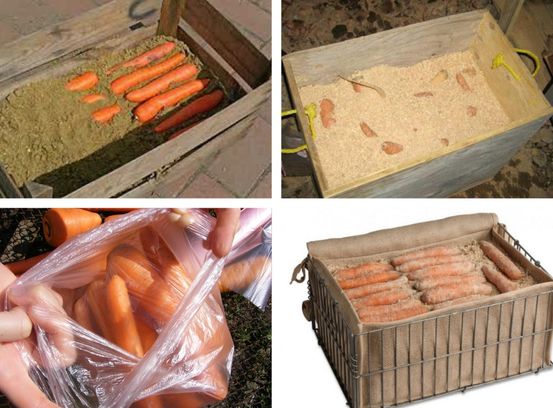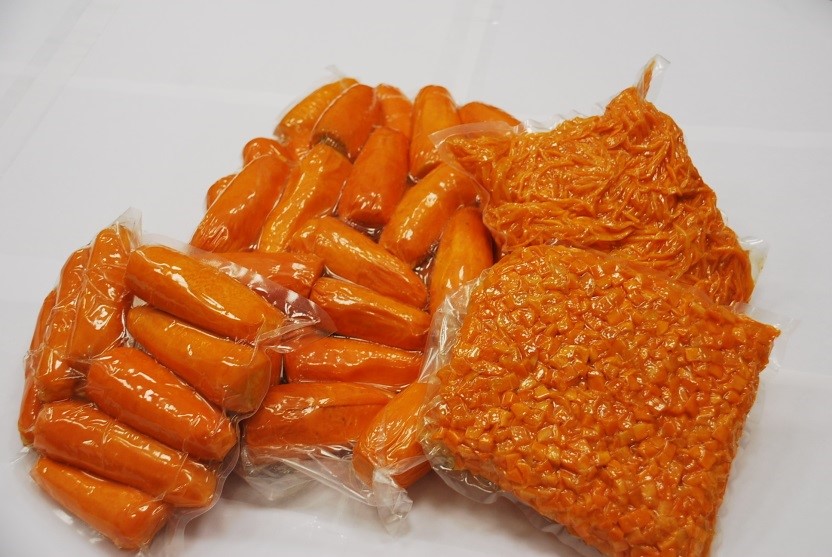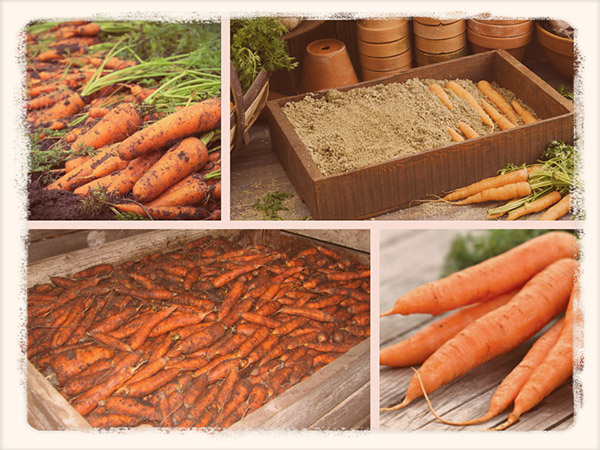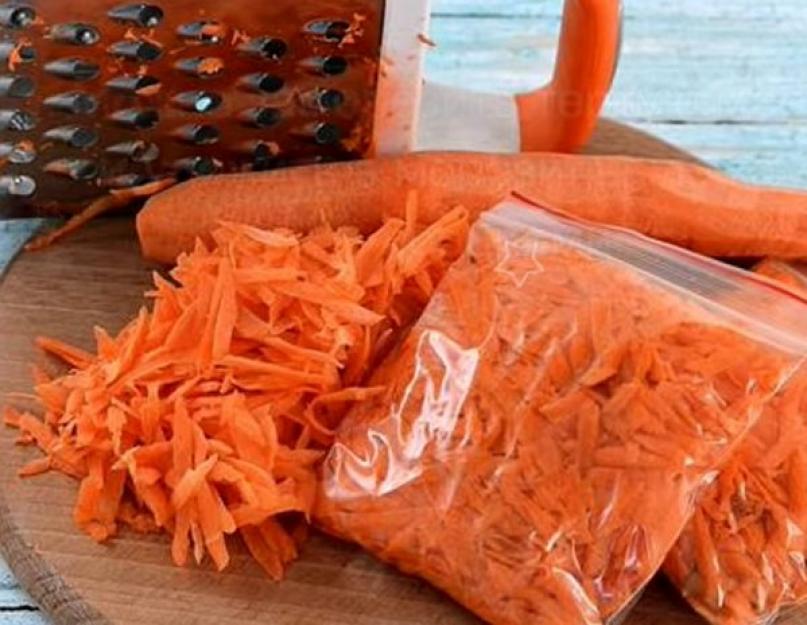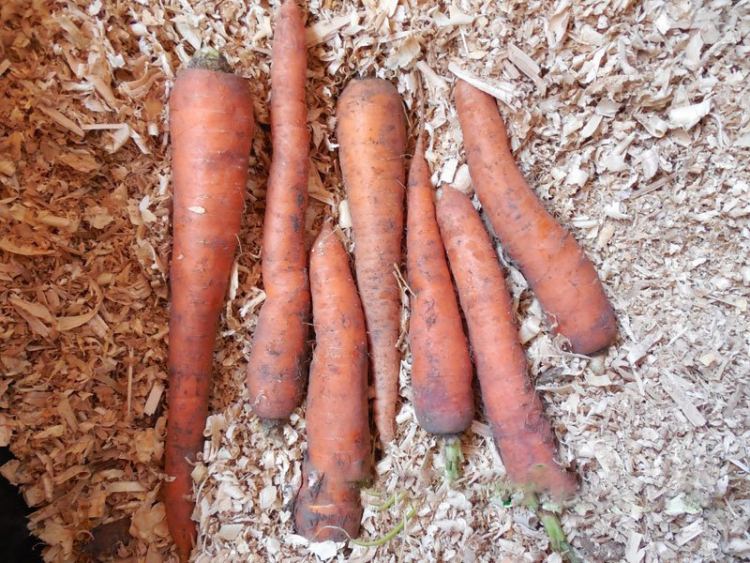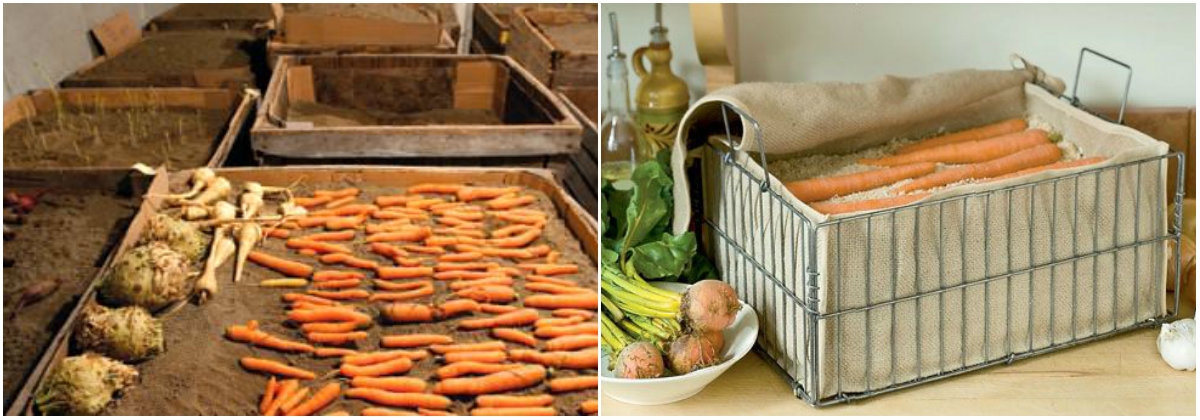Preparing carrots for storage
Agricultural experts recommend adhering to the following rules:
- Before harvesting, at least a week before, the vegetable crop is not watered.
- Cleaning is carried out in warm dry weather.
- After the fruits are removed from the ground, the tops should be cut off slightly above the head and left to dry for several hours in a sunny area, or under a canopy with good ventilation.
- Next, the carrots are cleaned of excess adhered soil.
- The next stage is to trim the upper part of the root crop (a layer about 1 cm thick), after which the vegetables must be kept in the cellar for 10 days at a temperature of + 10 ... + 14 ° С. This will become a kind of "quarantine", in which the cut points and minor mechanical damage are tightened, spoilage, rot and other painful manifestations on vegetables are found.
Immediately before being sent for storage, a final sorting is performed, removing all defective vegetables.
Processing methods
There are several ways to store root vegetables. Before storage, the carrots are treated with a manganese solution. Black rot, unlike white rot, which is characterized by rapid spreading when stored in a joint container, is not transmitted from vegetable to vegetable. Clean carrots in a large container (basin or bath) are treated with a manganese solution. The prepared dark purple solution is poured onto the roots placed in the container. Withstand for two hours, after the vegetables are taken out on a thick cloth or tarp and dried. This treatment will protect root crops only from white rot and pests, and does not exclude the possibility of being damaged by black rot.
How I prune carrots and beets before storage, gardener review:
How to properly prepare carrots for winter storage:
- The harvested crop of root crops is well cleaned of dirt;
- Each vegetable is inspected for damage;
- The root crop is washed when there is no other way to remove the contamination;
- Trimming the tops is done in the above way;
- Vegetable crops need to be dried in the air, without direct sunlight;
- Prepare clean storage containers - wooden boxes, polyethylene bags;
REFERENCE: Storage without containers is allowed - in piles, in bulk.
- Carrots are treated with manganese solution. The first layer is placed in a box and sprinkled with sand;
- Alternating layer by layer, fill each box. The boxes are not closed, they are lowered into the cellar for storage.
How to store carrots in an apartment
How can you stock up on vegetables for the winter if there is no cellar, no basement, no barn in city apartments?
A glazed balcony or loggia will do.
Of course, you will have to make sure that the temperature does not fall below zero, the sun's rays do not fall on carrot stocks.
Otherwise, your entire crop will sprout and rot.
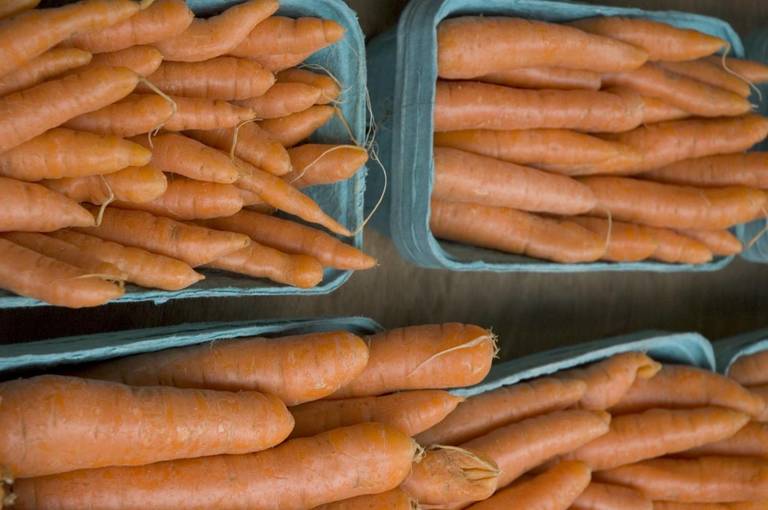
So let's take a look at the options.
The easiest and most effective way is to put the root vegetables in a box, crush them with coniferous sawdust, and wrap them in a thick old blanket.
In the same way, carrots are stored on the balcony in plastic bags. Sugar bags are also fine.
When frozen, vegetables are transferred to another place or even more wrapped in dense material, for example, felt.
Arrange root vegetables in boxes of wet sand in a loggia.
The vegetables will be as crispy and juicy as from the cellar, but they will not last long on the loggia, only until the middle of winter.
Stir the sand with ash or ash and bury the carrots there. This will keep the vegetables a little longer.
Storing carrots in the garage.
If your crop is small, you can wrap each root crop in newsprint and put everything in a wooden box.For the first time, such a stock will be enough for you.
How else do city mistresses get out?
Thoroughly washed and cut carrots are wrapped with food stretch film, placed in a container so that the fruits do not touch (this is enough for 45 days).
And the carrots are treated with paraffin. Paraffin is melted in a saucepan, washed and dried carrots are dipped into it, it is covered with a paraffin layer and can be stored on the balcony for 4 months.
And, of course, every city hostess's assistant is a refrigerator.
Put the carrots, clean, dry and cut from the tops, in small plastic bags and store them in the drawers of the refrigerator.
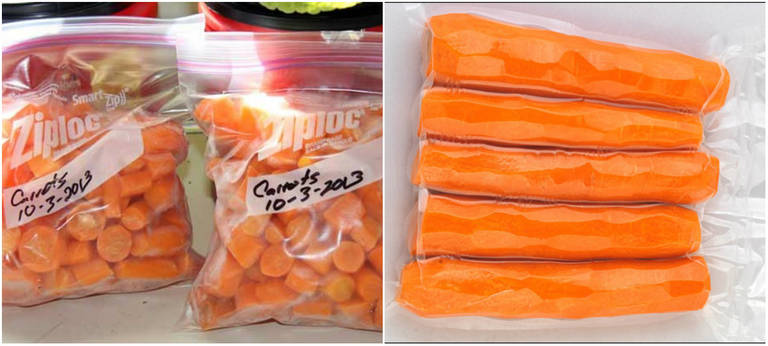
It is very convenient to store vegetables in special plastic containers with sealed lids (bowls).
Rinse, dry the carrots, put a paper napkin on the bottom of the container, fold the fruits and close the lid tightly.
In supermarkets there is a huge assortment of such containers: round buckets, rectangular dishes, transparent and colored jars. There are even containers for sale with tags and windows for inscriptions.
Freeze carrots in the freezer.
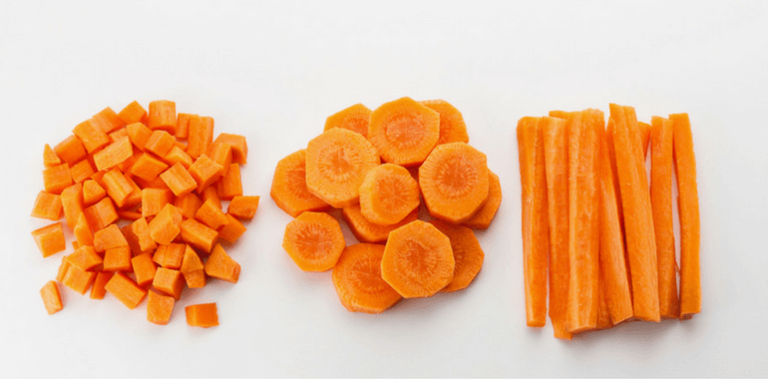
Cut or grate clean carrots and put them in regular bags. Better yet, prepare a few bags.
For soups and borscht, finely grate the carrots. In another bag, fold the carrots, cut into cubes and circles. Another is straw.
"A little trick: you can pack vegetable sets in sachets."
Fold diced carrots, zucchini, cauliflower, bell peppers in a small bag. You will always have ready-made assorted vegetables at hand.
How to store carrots in an apartment

A refrigerator and an insulated balcony are suitable for storing carrots at home.
In case of temperature drops in winter, it is important to ensure that it does not fall below 0 ° C on the balcony. From the sun's rays, the boxes are covered with dark material.
It is convenient to store carrots on the balcony in boxes with sawdust or sand. When frozen, they are wrapped in a warm blanket. In extreme cold, they are transferred to a warmer place or even more insulated.
In a private house, in the country
The best option for storing vegetables is the subfloor of a house or summer cottage.
When building or buying a home on their own land, they pay attention to the quality of the underground space - a convenient vegetable storage is obtained from it. Before laying root crops, the storage is prepared: they remove the remnants of the past harvest, ventilate
If necessary, disinfect - whitewash the walls, wash the shelves and the floor. Harvesting is carried out a month before laying vegetables, then airing for a long time
Before laying root crops, the storage is prepared: the remnants of the past harvest are removed, ventilated. If necessary, disinfect - whitewash the walls, wash the shelves and the floor. Harvesting is carried out a month before the vegetables are laid, then they are ventilated for a long time.
Store carrots in any way. Drawers and other containers are conveniently placed on lower shelves or on the floor.
In the basement, cellar
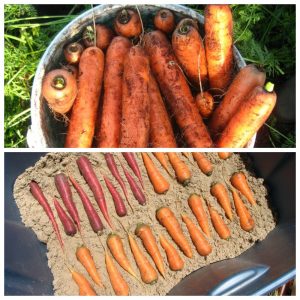
A basement is a room in any building that is half underground. It is called the first underground floor.
The cellar is a pit with fortified walls and a covered top. In private houses, a cellar is called a basement in cases where the foundation of the house is made with full floor filling. In village houses in the cellar, instead of the floor, there is ordinary earth, and the walls are the foundation.
The difference in construction does not prevent these premises from having the same characteristics:
- maintaining the optimum temperature - not lower than 0 ° С, humidity - 90-95%;
- air circulation.
In the fridge, freezer
Each refrigerator has containers for vegetables. They are located under the lower shelves. Carrots will be stored there for up to four months.
There are two ways to keep root vegetables in the refrigerator:
- Washed, cut and dried carrots are stored in plastic bags. When water droplets appear on the bags, it is recommended to dry the vegetables and replace the bag with a dry one.
- Root vegetables are wrapped in a wet cotton towel and placed in the vegetable compartment.
A popular and convenient storage method is in the freezer. Housewives cut carrots for different dishes: into strips, bars, rub on a coarse grater. This saves cooking time later.
Before placing the chopped root vegetables in the refrigerator, they are blanched - scalded with boiling water. As a result, the action of enzymes is slowed down. Pieces do not lose taste, color, structure. Once frozen, blanched carrots retain their nutritional value until the next harvest.
The cooled chopped fruits are laid out on flat surfaces and placed in the freezer for 2 hours. Then put in bags or containers and put into the freezer.
Preparing to bookmark
After harvesting, transportation, carrots must be intact, without mechanical damage, cuts, visible rot. Moisture is lost from the affected areas, fungal diseases can develop in them, which can destroy the entire crop.
The preparatory process includes timely, correct collection. It:
the timing of harvesting from the site - they, in turn, depend on the grade. Medium and late-ripening varieties are well adapted for long-term keeping quality. They begin to be picked from the soil in the last days of August and until the end of September. This period is characterized by a cessation of development, the completion of the increase in mass

careful removal from the soil so as not to damage the roots. If it is very dense, dry, use a shovel or a pitchfork to dig in. cleansing of adhered soil without the use of sharp instruments
cleansing of adhered soil without the use of sharp instruments
airing for two hours (no more) right in the garden
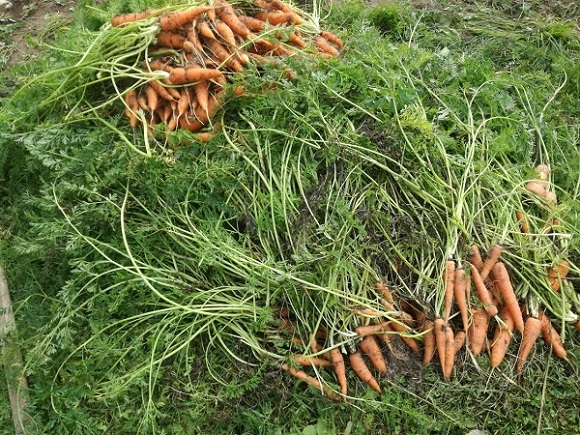
removal of tops - it is done using sharp garden shears, a knife, a pruner. It is cut down to the point of growth. Leaving greens (no more than five millimeters) contributes to its further growth, the root crop will gradually lose moisture, then taste, and then finally wither
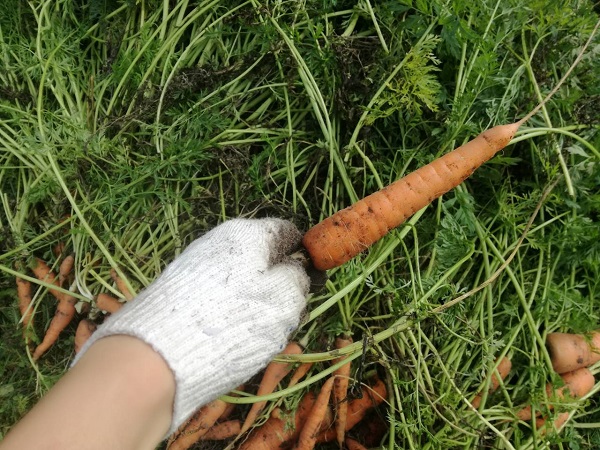
moving the harvested crop to a shaded, well-ventilated place for final drying, such as a garage or under a shed. It should not be on the ground, it is better to spread a dense, breathable fabric.
The vegetable will tell you the timing of harvesting from the garden itself. If the lower branches turn yellow and begin to dry out, you can start working.
It is strictly forbidden to wash carrots before placing them for long-term storage. Only those specimens are washed that are intended for storage in a refrigerator or freezer, pre-crushed.
Before storing carrots in the refrigerator, they are washed, dried, placed in polyethylene bags, in food grade plastic containers. These are good sealed containers in which the root crop can lie for more than a month.
The next step is calibration. Experts do not recommend storing large and small carrots together, they need to be divided. They also argue that the conical shape of the average carrot lies for a long time, and the cylindrical one should immediately go to processing. Although ... all this is verified by personal experience.
When is the harvest time?
Let's consider them in detail:
Variety
When harvesting, it is important to take into account the varietal belonging of the crop and focus on the ripening period specified by the manufacturer of the seed. Climatic features
The timing of harvesting from the garden will directly depend on the climate of the region in which the carrots are grown. So, in a warm climate, the crop can be harvested more than once a season, but in a harsh climate - only by the beginning of autumn and only once.
The presence of unfavorable weather conditions. If autumn comes early and is rainy and cold, digging can begin in September, but if autumn turns out to be velvety, tender, you can postpone the harvest until December.
Subtleties of care.With good care, the fruits can be harvested in accordance with the ripening time of a particular variety.
Fruit sizes. Large-fruited varieties ripen very quickly, and small ones, respectively, more slowly.
The condition of the lower part of the haulm. When the tops begin to wither and dry, you can start harvesting from the garden for the winter.
IMPORTANT: If you care for the carrot crop poorly or do not care about the growing crop at all, the ripening of the crop will take a long time, even if an early variety was planted on the site. What is the best and longest way to keep carrots until spring, and how to do it correctly at home so that it does not dry out over the winter? It is difficult to store carrots, but if you choose the right method, you can save the vegetable for a long time.
What is the best way to keep the carrot until spring, and how to do it correctly at home so that it does not dry out over the winter? Carrots are difficult to store, but if you choose the right method, you can save the vegetable for a long time.
Shelf life of carrots:
- From 2 to 3 months - in plastic bags.
- From 4 to 5 months - in paraffin.
- From 5 to 7 months - in boxes.
- 6 to 8 months - in the sand.
- 1 year - in clay.
- 1 year - in needles.
Timing:
- Optimal terms: late September - early October, in the case of a cold, rainy autumn, root crops are harvested early to prevent cracking from excess moisture.
- Carrots are harvested before the fall frost. A cold-caught crop becomes susceptible to disease and does not store well.
- It is best to dig up carrots in dry, sunny weather. You do not need to water the garden the day before.
- The average daily temperature for harvesting should not rise above 10 ºC and fall below zero.
Compliance with the rules for digging up carrots will help the vegetable to survive better:
- If the carrot beds are overgrown with weeds, they are weeded out before harvesting.
- In light sandy soil, the carrots are pulled out by the hands by the tops. In heavier ground, use a pitchfork or shovel. In order not to injure the root crops with the tool, they first dig out the ground a little, and then pry several bushes with a shovel at once.
- Carrots must be carefully peeled from the ground, being careful not to damage the skin.
- Each root crop should be carefully examined, vegetables with damage are laid aside separately and not placed in storage.
- For some storage methods, they are washed in running water. This will remove harmful microorganisms, the presence of which can significantly shorten the shelf life. It will also peel vegetables if they were grown in heavy loam.
- Sort the carrots by size. This will help to organize the storage correctly: first of all, small roots will be used, since they will lose moisture earlier, then medium and large ones.
- Prune carrots for storage. The procedure is performed as follows. If the root crop is planned to be left for seeds or used for food in the next 2-3 months, the tops are shortened at a distance of 1-2 cm from the carrot head. If a longer storage is planned, then to prevent germination, cut off the ground part with a sharp, clean knife, grabbing up to 1 cm from the edge of the head.
If the weather is dry, the carrots are dried outdoors in the shade. If it rains, then it is placed in a cool place - a shed, garage. The temperature during this time should not rise above 5 ºC. Vegetables are placed on a clean surface, avoiding root vegetables in contact with each other.
After drying for one and a half weeks, the harvested carrots are kept in quarantine without storing. If sick or damaged vegetables are found during this time, they are discarded upon re-examination.
Preparation
In our diet, the orange root crop should be every day, both in winter and summer.
In a private house, storing crops is, of course, easier and more convenient, there is a cellar, an underground, a barn, but in city apartments you can also find an excellent place to store vegetable supplies.
We will find out which variety of carrots to choose and how to keep stocks at home until spring.
So, we sort out the carrots.
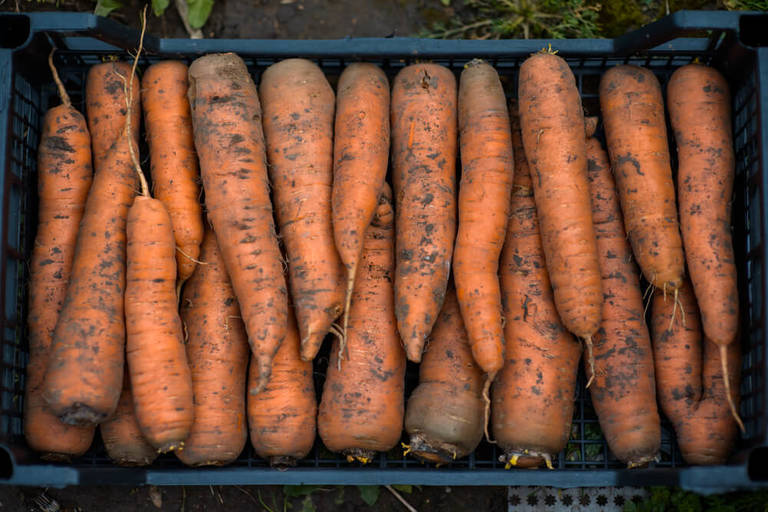
For long-term savings, we select ripe, whole and not withered root crops.
"Be aware, one spoiled plant will infect an entire crop."
Sort the fruits into large and small, you will store them separately.
If there are root crops that are soft, with dry rot or damaged during harvest, they will be used immediately.
You can also wash such carrots thoroughly, peel, grate or in a food processor and freeze.
Here are some tips to help you keep carrots for a long time:
- 1 Vegetables for storage must not be washed. Shake off large clumps of earth, cut off the tops.
- 2 Before storing carrots for storage, they must be ventilated and dried thoroughly, covered from direct sun.
- 3 Wherever you store carrot stocks, in the basement, garage, on the balcony, the temperature in this room should be 0–2 ° C. Lay different varieties of root vegetables separately, because some species can germinate even at zero temperature.
- 4 Do not forget to periodically check your supplies for frozen vegetables and mold.
- 5 Experienced gardeners have found that medium-sized, conical carrot varieties are best preserved.
For those who are versed in varieties.
From mid-season varieties, choose the Red Giant, Moscow Winter, Flakke, Viking, Altair.
Late-ripening species tolerate storage well: Queen of Autumn, Cascade, Karlena, Chantane.
Early varieties, rounded short in shape, deteriorate quickly enough and are not subject to winter storage.
Carrot and green bean salad
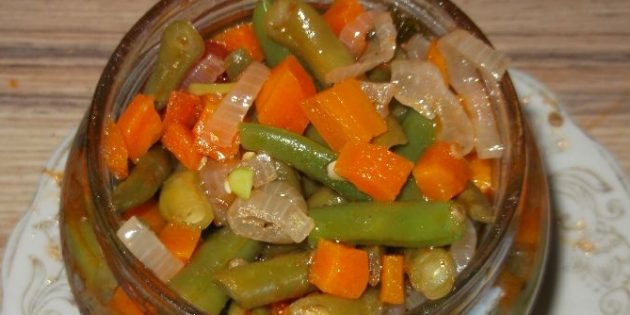
Ingredients
- 500 g carrots;
- 300 g green beans;
- 3 small onions;
- 5 small tomatoes;
- ½ bunch of basil;
- 50 ml of vegetable oil;
- 6 black peppercorns;
- 1 teaspoon ground black pepper;
- 2 teaspoons of sugar;
- 2 teaspoons of salt
- 40 ml vinegar 6%.
Preparation
Cut the peeled carrots into small cubes. Cut off the edges of the beans and chop into pieces 2–3 cm long. Chop the onion into half rings.
Pour boiling water over the tomatoes, peel and cut into large wedges. Chop the basil coarsely.
Place the carrots, onions and tomatoes in a saucepan. Pour in the oil and, stirring occasionally, cook over low heat for 10 minutes. Add beans, basil, pepper, sugar and salt. Simmer, stirring occasionally, for another 5-7 minutes.
Pour vinegar into the salad, mix and place in the jars along with the juice that has come out. Cover with sterilized lids and place in a saucepan lined with cloth.
Pour warm water over the shoulders of the jars and bring it to a boil. Sterilize small jars for about 7-10 minutes and larger containers 5-10 minutes longer. Roll up cans with blanks, turn over, wrap and cool.
- 10 ways to prepare delicious eggplant for the winter →
- 10 cool ways to prepare zucchini for the winter →
Features of storing root crops in storage
In order for the carrots to retain their quality for a long time, it is not enough just to lower them into the cellar. There are already effective ways of special planting root crops:
a large pan, preferably enameled, a bucket, any other container, but must be closed - vegetables are placed in them vertically, covered with a thick cloth, and covered with a lid. The material is able to absorb the fumes coming from fresh fruits, and then it will give them back in the form of moisture
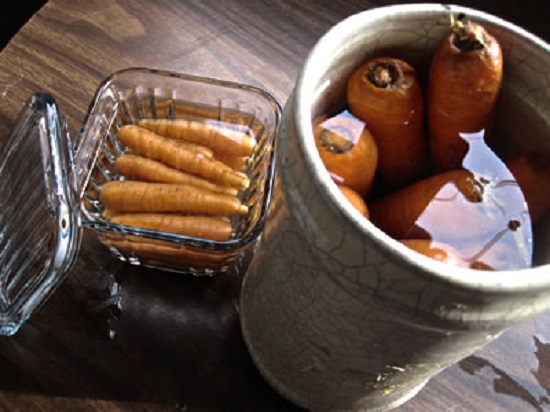
bags of various materials - fabric, polyethylene, canvas with a volume of up to fifty liters. In them, the roots are placed randomly, and the layers are sprinkled with fresh sawdust.Such a container should not be tied, vegetables need air exchange, otherwise carbon dioxide will accumulate in the sealed bags, putrefactive bacteria will begin to multiply, spoiling the vegetable. Bags are installed with an open mouth and vertically in a dark, dry place, you can in the corner of a basement or cellar
boxes made of hard plastic, wooden, boxes made of thick cardboard are also used for long-term storage of vegetables. Carrots of the same size are staggered (head to tail) without touching each other. Each layer is sprinkled with any material - just sawdust, garlic, onion peel, which is an excellent disinfectant against fungus and the appearance of rot. They also use wet sand, which preserves the juiciness of the vegetable for a long time.
the ideal way to preserve carrots for nine months is clay in the form of a liquid solution. Of course, the method is dirty, laborious, but worth it. Clean root vegetables, dipped in such a chatterbox, laid out to dry (purchase a dry crust) and placed in cardboard boxes, plywood, boxes, plastic bags, which are left untied
in the absence of shelves, suitable containers, the carrots are poured directly onto the floor, but before that a thick layer of sand is poured into an already defined place, vegetables are put into it as well as in the above container - in layers

right in the beds, which are prepared accordingly. After trimming the tops, the carrots are placed in a small depression, previously sprinkled with dry sand. All this is covered with a high-density film, then it is covered from above with a thick insulating layer of any material. You can use spruce branches, fallen leaves, sawdust, peat, and on top as a topcoat and so that the insulation does not get wet, they put roofing material. Such a shelter will protect root crops from frost, heavy rainfall and keep them fresh until spring.
It is important to remember that such a bed does not open in winter; carrots can be eaten only in early spring and until the next harvest. Basement, cellar, barn eliminate the problem of storing vegetables, but what should the residents of multi-storey buildings do?
Basement, cellar, barn eliminate the problem of storing vegetables, but what should the residents of multi-storey buildings do?
How to properly store carrots in a private house and apartment in winter?
A private courtyard (dacha) often has a basement - this is the best place to store vegetables.
It all depends on the variety and preparatory work. The degree of preservation is influenced by the fact that purchased carrots are laid in the basement or grown in the garden.
In apartment conditions, the root crop retains its qualities if it is placed on a balcony, where it is not cold, in winter or in a storage room. It also requires preparation and proper location.
In addition to preserving at home, options with harvesting root crops for future use are suitable here. For example, canning, drying or freezing.
A small amount can simply be placed in the refrigerator, where the roots can lie and not spoil for up to 2 months.
 Subject to the conditions, carrots can be stored until spring and even until summer.
Subject to the conditions, carrots can be stored until spring and even until summer.
Traditionally, containers for storing carrots were not used, they simply poured a pile of sand and buried root vegetables in it. Now this method is often abandoned using plastic or wooden containers.
The roots are laid in an even layer, leaving small gaps so that sand can wake up there without problems.
Sprinkle sand on top of the carrot layer so that it is well covered. Everything is well leveled for the next layer of root crops.
Tip: instead of sand, root crops can be sprinkled with sawdust or onion husks.
Layers alternate as long as the height of the box allows. If necessary, you can store several boxes, it all depends on the number of carrots.
There is no need to cover the boxes except for sand.Read about how to properly prepare root vegetables in the material below.
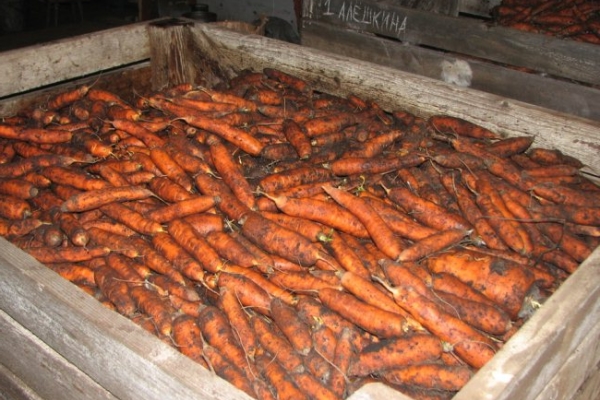 In the cellar, root vegetables can be stored in wooden or plastic boxes in sand, sawdust or onion skins.
In the cellar, root vegetables can be stored in wooden or plastic boxes in sand, sawdust or onion skins.
On the balcony
Before the onset of cold weather, the safety of vegetables can be ensured even on non-glazed balconies. However, it is better if there is a balcony, protected from moisture and the sun, where the temperature in winter is observed - 0 - 1 ° C.
You need to store carrots in boxes, replacing the layers with newsprint. Cover the top of the box with cellophane and a cloth, the roots will have enough moisture and coolness.
Tip: instead of paper, you can use sand as in the basement version.
Freeze in the freezer
Almost all vegetables are preserved by freezing; carrots are ideal for this purpose. This method will save time on cooking, because the vegetable will be peeled and chopped.
Root vegetables must be cleaned and rinsed under running water before placing inside the freezer. You can freeze carrots in different ways:
- cut into cubes, rings or strips;
- grate or grind with a combine;
- use a Korean carrot grater;
- cut into cubes or whole.
Chopped vegetables are placed in plastic bags or sealed containers for freezing. Placed inside a chest freezer or freezer compartment. The only negative when frozen is that vegetables lose 65-80% of their usefulness.
Important: you can store in this way until the next harvest, this method will never fail. Chopped vegetables are laid out in plastic bags or sealed containers for freezing
 Chopped vegetables are laid out in plastic bags or sealed containers for freezing
Chopped vegetables are laid out in plastic bags or sealed containers for freezing
Is it possible to store in the apartment in the refrigerator
Inside the refrigerator, root vegetables are able to maintain their value and shape for a fairly long period.
Carrots will feel comfortable on the bottom shelf of the refrigerator if you follow some rules:
- Prepare root vegetables correctly, in no case wash them.
- Washed carrots are not suitable for long-term storage. If it is washed, dry it, place it in a plastic bag. Close it hermetically, then moisture will remain inside.
- In the case of unwashed vegetables, dry them. Enumerate so that there is no rot and damage. Put a plastic bag inside and tie it so that there is no air access.
- For storing vegetables, a special niche or shelf at the bottom of the refrigerator is usually used.
If everything is in order, don't worry. If putrefactive damage is found, it is better to process or freeze such carrots.
In packages at home
If you put root vegetables inside a bag and store it in an apartment, if the vegetables are of high quality, they can lie like this for 2-3 weeks.
However, there is no guarantee that they will not start to deteriorate. The top may look good, but the inside of the carrots will start to rot.
With this method, you need to regularly check the packages for putrefactive changes.
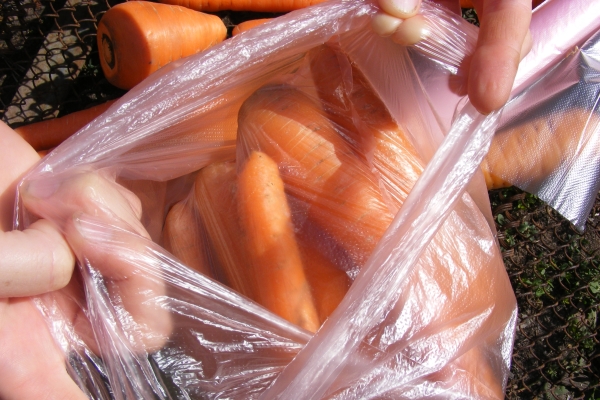 If you put root vegetables inside a bag and store it in an apartment, they can lie like this for 2-3 weeks.
If you put root vegetables inside a bag and store it in an apartment, they can lie like this for 2-3 weeks.
Basic ways
A large number of methods are used to preserve the root crop throughout the winter. These methods allow you to store the vegetable without compromising the taste.
In sand
To use this method, you must first sift the sand. The root crop is folded into a box, sand is poured on top in a thick layer. A second layer of carrots and sand are laid out on top. The box is placed in a cool place and periodically moistened.
Important. In order for the carrots to be preserved for a long time, it is necessary to spread the vegetable at a distance from each other, this will reduce the risk of damage to one copy of the infection of the rest
In sawdust
Sawdust is a simple method of storing vegetables. Carrots must be dried and peeled from soil. A layer of sawdust is poured into wooden boxes and vegetables are laid out.Top layer of sawdust. In this way, several layers can be made until the box is completely filled.
In plastic bags
This method is used if the harvest is large. The root crop is folded into bags that are not tied and stored in a cool place. Vegetables must be sorted periodically, removing damaged ones.
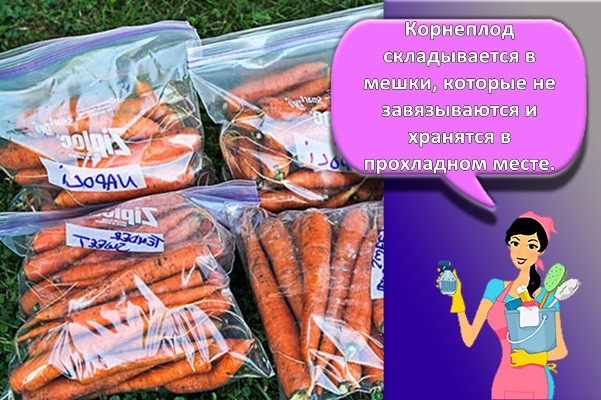
In clay
The use of clay reduces the risk of penetration of harmful microorganisms. A slurry made from clay and water is used.
Fill
The box is lined with foil, and the prepared carrots are laid out in a thin layer, filled with clay and left to dry completely. After the first layer is dry, you can fill the second layer.
Dipping
This method is more complex. The root vegetable must be treated with garlic water in order to remove all germs. After that, the root vegetable is dipped in clay to form a shell and dried in direct sunlight.
In the moss
Using moss allows you to remove excess moisture and create a natural environment for vegetables. Moss is laid out in wooden boxes, carrots on top. The root crop is also covered with a layer of moss. Multiple layers can be used in one box.
In a saucepan
Large containers are used, which must be pre-washed and dried in the sun. The harvest is folded into an enameled container and tightly closed with a lid. Place the pan in a cool place.

In onion skins
Onion peel disinfectant. The husks must be dried before storing vegetables. The root crop is folded into a box, and onion husks are poured on top. Vegetables are stacked in layers, at a short distance from each other. This storage method allows you to preserve all the taste of carrots throughout the winter.
In the garden
This method is used for those who have a large harvest.
The carrots are not dug up, the tops are carefully trimmed. Sand is poured on top, and leaves are laid
You can use such a vegetable in the spring after the snow melts.
In cling film
Suitable for small quantities. The peeled carrots are carefully wrapped in plastic and placed in the refrigerator in the vegetable compartment. Each carrot is individually wrapped in foil. This will reduce the risk of damage to the rest of the roots.
3> In paraffin
Allows to form a shell that protects the crop from the penetration of harmful microorganisms that cause rotting. For use, the paraffin is melted in a water bath. Using a brush, apply a thin layer to the root crop. The root crop is suspended to dry completely. For this method, it is recommended to cut off the tops after the shell has dried.
For preparation, mix a small amount of chalk with water until a liquid consistency is obtained. Dip the fruits in liquid and leave to dry. After the appearance of the chalky shell, put it in a box.
Preservation of carrots within the apartment
If there is no garage, basement, cellar, where is it better to store carrots in an apartment? Experienced gardeners recommend proven techniques:
on the loggia, glazed balcony, you can place boxes, bags with vegetable supplies, sprinkled with husks, sand, sawdust. The loaded container is installed and wrapped. For this, any material that retains heat is suitable - old blankets, shabby outerwear, felt, etc. In this case, you need to monitor the temperature regime on the loggia, balcony so that the vegetables do not get warm and do not get stuck
in a pantry without heating, a root crop is well preserved, wrapped in any paper, folded in a wooden box, a cardboard box. Suitable for small quantities of root vegetables
in the refrigerator, carrots lie in plastic bags and plastic containers for a long time. To return to such specimens freshness, taste, juiciness, their lower part must be cut off and put with this cut down in a bowl of water.After two to three hours, the carrots will regain their properties.To enhance the effect, add three pieces of ice to the water
it is better to put pre-chopped carrots in the freezer - in a blender with different attachments, on an ordinary fine, coarse grater, cut into pieces of any shape and folded in small portions into plastic bags special for freezing

covering of root crops with paraffin - they must be washed, dried, then each dipped in melted paraffin, dried, folded into a refrigerator or in a pantry
Before preparing for storage in an apartment, the vegetable is kept for some time at a temperature of plus fourteen. During this period, accidental small cuts, injuries will be delayed, and damaged specimens will show the affected areas (such are immediately recycled or thrown away).
With proper preparation and storage, a useful product will perfectly last until a new harvest and at the same time will not lose its useful qualities.
Carrot storage rules
Harvesting begins in the second half of September or closer to October, it is recommended to choose sunny dry weather. It is undesirable for plants to fall under frost. Cracks and other damage always rot, so only whole roots are selected. If the roots are intertwined with each other, you won't be able to keep them for a long time.
Each has its own storage method, you can lower it into the cellar, underground, sprinkle with sand, small ones are washed, grated, laid out in bags and frozen. Such products are used in the preparation of soups, borscht.
You can use sugar bags, collect the entire crop there. This method is suitable for placement in the basement if there is no cellar. For disinfection, a little ash is added to the bag.
Preservation depends on the variety and characteristics of cultivation, treatment with chemical reagents at industrial enterprises.
Preparation:
- It is forbidden to wash the plants before laying, this procedure is only suitable for freezing.
- Everything is inspected, the damaged ones are used for conservation.
- After sorting, a simpleton is performed, prolonged exposure to sunlight is undesirable, from time to time everything turns upside down.
- Strong and sealed bags, scotch tape vacuumizers are used.

Warehousing methods:
- Loamy sand, water and a few boxes are used in cool rooms, garage pits. Evaporation of moisture in such conditions decreases, the development of putrefactive diseases is inhibited, the temperature remains stable for a long time, does not change.
- For each bucket of sand, 1 liter of water is taken, the prepared material is poured into a box, roots are laid on top, there should be a distance between them. The contents are covered with another layer of sand, according to this principle, the entire box is filled.
- As a filler, coniferous sawdust is often used, containing phytoncides, which inhibit germination, the development of fungi and microbes, the contents are stacked in layers, sprinkled on top with shavings.
- Plastic bags with a volume of 5 to 30 liters are left open in cold cellars. The humidity in which containers is maintained at 96-98%, wilting is prevented. During storage, carbon dioxide is released, which evaporates from open bags. The contents will become unusable if the bags are tied.
- Holes are made to close the bags and not spoil the contents. To maintain the humidity level in the room, lime is scattered near the bags to absorb the liquid.
- The clay helps to create a protective layer on the surface to prevent wilting in winter. Half a liter of clay is poured with water, everything is mixed every other day. After 3-4 days, a substance with the consistency of sour cream is formed. A film spreads to the bottom of the storage container, carrots are laid out, filled with liquid clay. The next layer lays down when the previous one dries.
- Root vegetables are alternately dipped in a garlic clay mash, dried, folded into boxes.
- Sometimes sphagnum moss is used, the bud of the plant has strong preservative properties, regulates the amount of carbon dioxide.
- Enamelled metal pots are suitable for storage, each carrot is washed, the tops are cut, dried in the sun. The crop is stacked vertically, covered with a napkin and a metal lid. If you put the container in a cool basement, you can store the plants until the next harvest. Essential oils, which are contained in onion and garlic peels, prevent rotting, so the shelf life is prolonged.
Main recommendations:
- The correct choice of variety.
- Providing a suitable storage temperature.
- Regulation of oxygen access.
- Optimum humidity level.
- Protection from pests.

